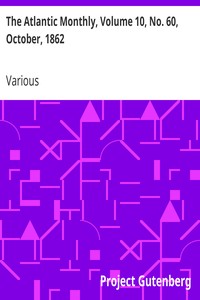The Atlantic Monthly, Volume 10, No. 60, October, 1862 by Various
"The Atlantic Monthly, Volume 10, No. 60, October, 1862" by Various is a magazine of literature, art, and politics compiled during the mid-19th century. The opening portion presents a reflective examination of autumn, particularly focusing on the vibrancy of autumnal foliage in America, which is depicted as a stunning natural phenomenon often overlooked in literature and poetry. The beginning of the volume sets an evocative tone, describing the brilliant aesthetics of autumn
leaves and their transition in color. The author muses on the brilliance of leaves during the season, comparing it to the ripening of fruit and emphasizing its beauty as a vital part of nature's cycle. As details unfold, there are contemplations on the legacy of these natural displays in literature, and reflections on personal experiences connecting the beauty of the season to deeper philosophical and emotional reflections about life and maturity. The writing invites readers to take notice of the subtle yet profound beauty in the world around them, suggesting that appreciating nature's hues can lead to greater insights in life. The second part of the opening transitions to a narrative focusing on a character named Palmer, who is dealing with loss and the burdens of war. He is depicted as emotionally jaded, grappling with the realities of life during the Civil War era, particularly as he prepares for an upcoming conflict at Blue's Gap. He reflects on love and duty, and the impact of war on relationships and personal beliefs. The interplay of personal loss, political sentiments, and the harsh realities of warfare serve to provide depth to characters such as Scofield and Gaunt, further revealing the tumultuous emotional landscape that individuals navigate during such historical upheaval. The narrative juxtaposition of nature's beauty and the grim struggle of war enriches the reader's understanding of the time period and the human condition amidst conflict. (This is an automatically generated summary.)
Read now or download (free!)
| Choose how to read this book | Url | Size | ||||
|---|---|---|---|---|---|---|
| Read online (web) | https://www.gutenberg.org/ebooks/10077.html.images | 562 kB | ||||
| EPUB3 (E-readers incl. Send-to-Kindle) | https://www.gutenberg.org/ebooks/10077.epub3.images | 294 kB | ||||
| EPUB (older E-readers) | https://www.gutenberg.org/ebooks/10077.epub.images | 300 kB | ||||
| EPUB (no images, older E-readers) | https://www.gutenberg.org/ebooks/10077.epub.noimages | 270 kB | ||||
| Kindle | https://www.gutenberg.org/ebooks/10077.kf8.images | 535 kB | ||||
| older Kindles | https://www.gutenberg.org/ebooks/10077.kindle.images | 505 kB | ||||
| Plain Text UTF-8 | https://www.gutenberg.org/ebooks/10077.txt.utf-8 | 502 kB | ||||
| Download HTML (zip) | https://www.gutenberg.org/cache/epub/10077/pg10077-h.zip | 286 kB | ||||
| There may be more files related to this item. | ||||||
Similar Books
About this eBook
| Author | Various |
|---|---|
| Title |
The Atlantic Monthly, Volume 10, No. 60, October, 1862 A Magazine of Literature, Art, and Politics |
| Note | Reading ease score: 68.4 (8th & 9th grade). Neither easy nor difficult to read. |
| Credits | E-text prepared by Joshua Hutchinson, David Kline, and Project Gutenberg Distributed Proofreaders |
| Language | English |
| LoC Class | AP: General Works: Periodicals |
| Subject | American periodicals |
| Category | Text |
| EBook-No. | 10077 |
| Release Date | Nov 1, 2003 |
| Most Recently Updated | Dec 19, 2020 |
| Copyright Status | Public domain in the USA. |
| Downloads | 98 downloads in the last 30 days. |
| Project Gutenberg eBooks are always free! | |

